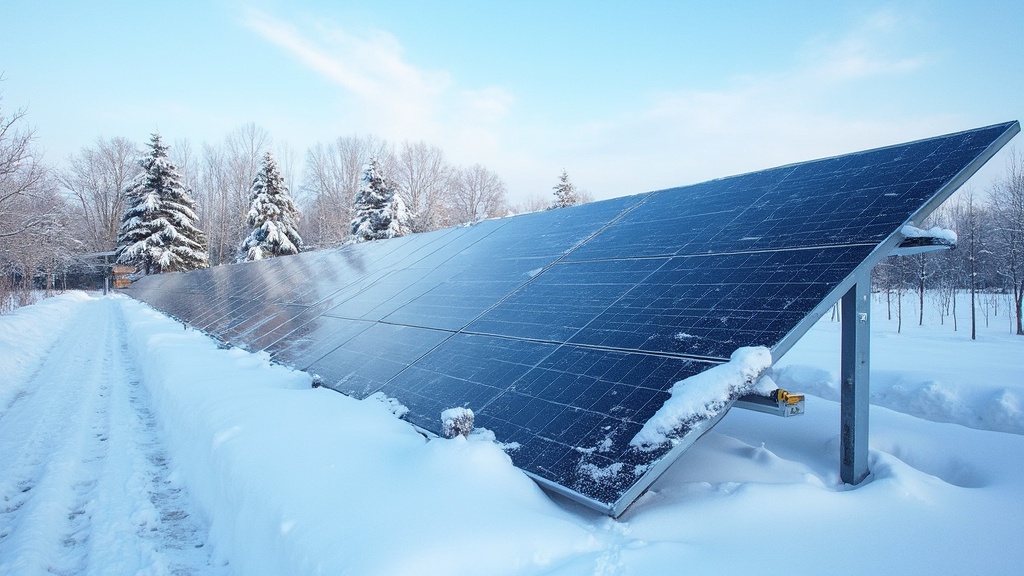Introduction
As winter approaches, many homeowners may wonder how their solar panels will perform in the chillier months. Surprisingly, solar technology is more resilient than it may seem, continuing to generate energy even in less-than-ideal conditions. With shorter days and overcast skies, the efficiency of solar panels might be challenged, but the cold can actually enhance their performance.
This article dives into the fascinating world of winter solar panel efficiency, offering insights on how to maintain and maximize output during the season. From understanding the impact of snow on energy production to practical maintenance tips and the best solar technologies for winter, this guide aims to empower homeowners to make the most of their solar investment, ensuring that their systems remain productive throughout the colder months.
Understanding Solar Panel Efficiency in Winter
You may be astonished to discover that solar panel work in winter can indeed be very effective during the cold months! While it’s true that shorter days and overcast skies can limit sunlight exposure, your energy collectors are still hard at work generating electricity, even in those low light conditions. In reality, the cold of the season can enhance solar panel work in winter, allowing photovoltaic cells to transform sunlight into power more efficiently than in the warmth of summer.
Research indicates that photovoltaic panels generate approximately 10 to 25% of their typical output in winter, with a significant variation of about 0.73 GW in comparison to sunnier conditions. This indicates that even on overcast days, your photovoltaic system is generating power that can assist in supplying your home. Significantly, case studies from different areas, including a household in Southern California, have demonstrated considerable savings with photovoltaic technologies, where utility costs were lowered by more than 70% after introducing heating systems.
Furthermore, sunlight-powered air heaters can reduce a household’s carbon emissions by 20 to 40 percent and decrease monthly utility costs by 30 percent, making them an attractive choice for different residential situations. Furthermore, the anticipated investment in photovoltaic systems is expected to reach £162.1 billion by 2033, highlighting the increasing significance and dependability of renewable power. Understanding the factors that affect the production of photovoltaic systems, such as efficiency ratings and degradation rates, is crucial for evaluating how solar panel work in winter.
So, rest assured that your investment in renewable energy is still paying off, no matter the weather!
Maximizing Solar Output: Essential Winter Maintenance Tips
To ensure your solar panels are working at their best during the winter months, here are some friendly maintenance tips that can help you maximize their output:
- Regular Cleaning: Snow and dirt can accumulate on your surfaces, blocking the sunlight they need to operate efficiently. A gentle approach is best—consider using a soft brush or a hose to remove any snow. If the snow is light, you might even let it melt naturally. Remember, keeping those panels clear can significantly enhance your power production! As experts note, a significant drop in energy production can often be attributed to dust and debris buildup, making regular cleaning essential.
- Check for Obstructions: As winter progresses, the sun’s angle changes, which can create new shadows from nearby trees or shrubs. Regularly trim any foliage that might block your surfaces. This small step can make a big difference in maintaining optimal performance.
- Monitor Performance: Stay connected with your system’s output by keeping an eye on your power production through your monitoring system. If you observe a significant decline in output, it may be time for a more thorough examination of your units.
Studies indicate that low surrounding temperatures can indeed enhance the effectiveness of photovoltaic systems, so don’t let winter deter you from understanding how solar panels work in winter to maximize your renewable power potential! In regions where snowfall exceeds 30 inches in January, such as 18 states, these maintenance tips become even more crucial for eco-conscious homeowners. Furthermore, recent insights indicate that maintaining clean panels not only enhances their performance but also supports your goal of a more sustainable and environmentally friendly home.
The case study titled “Improving Solar Panel Efficiency in Winter” outlines various strategies, including system design and energy storage, that can significantly enhance performance during the cold months. Furthermore, the insights on Tesla home chargers and government energy programs highlight the innovative solutions available to homeowners. Significantly, researchers from the Indian Institute of Engineering Science and Technology have created a model to estimate dust buildup on photovoltaic surfaces, which can inform maintenance practices.
Data indicates that the median loss rate for photovoltaic system performance is 0.75% per year, with 90% of systems encountering less than a 2% loss each year, underscoring the importance of routine maintenance. By following these straightforward suggestions, you can help ensure that your solar panels work in winter continue to shine, even in the cold. And as A D Burakova from the Industrial University of Tyumen highlights, flexible photovoltaic systems are especially well-suited to infrastructure needs, demonstrating their versatility and effectiveness in various conditions.
Remember, a little bit of winter maintenance goes a long way in keeping your energy system running smoothly!
Snow and Cold: How They Affect Solar Panel Performance
Snow can affect how solar panels work in winter regarding solar energy performance. On one hand, heavy snow can cover your panels, which impacts how solar panels work in winter by blocking sunlight and decreasing power production. On the flip side, the reflective properties of snow can actually enhance power generation when the sun makes an appearance.
In fact, sunlight reflecting off the snow can enhance the quantity of power your photovoltaic system generates. Additionally, photovoltaic modules are cleverly designed to be slippery, allowing snow to slide off easily, which helps keep them clear. However, if snow builds up too heavily during solar panel work in winter, it can significantly impede power generation, so a little manual removal can go a long way in maintaining efficiency.
Interestingly, cold temperatures can be advantageous for solar panel work in winter. They tend to work more efficiently at lower temperatures, converting sunlight into energy with greater success. This indicates that even during those cold months, solar panel work in winter allows your energy system to operate effectively.
As one specialist remarked, utilizing photovoltaic energy with a battery backup is a game changer; it ensures your home can flourish during cold season power outages, just like those notorious New England storms. Additionally, the anticipated lifespan of a PV system is generally 25–30 years, highlighting the long-term dependability of photovoltaic technology even in winter conditions. Additionally, predictive modeling of snow shedding has been shown to enhance forecasting tools, allowing utilities to manage power fluctuations effectively, as demonstrated in a recent case study titled ‘Grid Stability through Predictive Modeling.’
By comprehending how snow and cold conditions influence your energy systems, you can guarantee they continue producing power, regardless of the season! And remember, professional upkeep can help maximize your energy system efficiency, extending their lifespan while contributing to a cleaner environment.
Preparing Your Solar System for Winter Challenges
Getting your energy system ready for the cold months is crucial to ensure it continues to function effectively, especially when considering how solar panel work in winter can be impacted. Here are some friendly tips to help you get ready:
- Examine Your System: Before the cold season arrives, it’s a great idea to have a specialist from Powercore Electric check your energy collection devices and inverter. Our expert inspection services can help identify any potential issues that might affect performance when the snow starts to fall. Remember, catching problems early can save you from bigger headaches later, ultimately protecting your investment and ensuring your home remains energy-efficient!
- Adjust Angles: If your energy system permits, think about modifying the angle of your modules to more effectively capture the lower winter sun. The angle of inclination of the solar panel should not be reduced to less than 53° to maintain the possibility of natural cleaning and maximize sunlight exposure. This simple adjustment can significantly enhance your power capture during the colder months, helping you combat rising costs more effectively.
- Power Usage Strategy: Planning your power consumption wisely can make a big difference in winter. Consider utilizing energy-efficient appliances and attempt to move energy-intensive tasks to sunnier days when your output is typically higher. This strategic approach not only aids in utilizing the energy you generate but also keeps your energy bills in check, reinforcing the economic and environmental advantages of heating systems.
For additional insights, explore our recent posts on how solar panel work in winter and the advantages of government renewable energy programs. By following these steps, you can help ensure your solar system is well-equipped to handle winter challenges. As Ilya Anisimov notes in his research, “understanding the factors that influence power generation is key to optimizing performance.”
This is especially pertinent when reflecting on the findings from the case study on capacity factor calculations, which highlights the significance of precise estimates for evaluating generation potential in different conditions. Take these preparations seriously as you approach the colder months and enjoy the long-term sustainability of your energy system!
Choosing the Right Solar Technology for Winter Performance
When it comes to selecting the appropriate solar technology for cold weather performance, it’s essential to explore how solar panels work in winter and consider a few solid options.
-
Monocrystalline Modules: These structures excel in efficiency—particularly in low-light conditions. They can maintain strong performance even on those chilly, overcast days of winter, showcasing how solar panels work in winter makes them a top choice for many homeowners.
Notably, through the use of tempered glass, aluminum casing, and a steady back sheet, monocrystalline units can maintain the ideal internal temperature of 40 to 55 degrees Fahrenheit even during the coldest winter storms.
-
Bifacial Modules: If your home is in a snowy area, bifacial modules can be a game-changer.
They capture sunlight from both sides, so when the sun reflects off the snow, you get a little extra boost in energy production. This is particularly beneficial in regions where snow loads are calculated using ASCE 7, ensuring that your installation can handle the specific snow load requirements.
-
Thin-Film Solar Cells: Although typically less efficient, these devices have their perks. They tend to perform better in warmer temperatures and can be a great fit depending on your specific installation needs. Additionally, polycrystalline photovoltaic modules, recognized for their cost-effectiveness, provide an efficiency range of 15-22%.
While they are slightly less efficient than monocrystalline options, their affordability makes them a viable choice for many homeowners.
Alongside your renewable energy setup, consider incorporating a Tesla home charger to maximize your energy efficiency, allowing you to utilize the energy generated from your setup to power your electric vehicle. Furthermore, explore local government initiatives that may offer incentives for installation, which can help offset costs and promote sustainability.
Regular maintenance, including cleaning services for your panels, is essential to ensure that solar panels work in winter optimally. Lastly, exploring battery options for renewable energy can enhance your energy storage capabilities, providing backup power when the sun isn’t shining. As always, it’s wise to chat with a solar specialist who can help you find the best option tailored to your home and climate.
This way, you can enjoy those winter sunshine benefits, no matter the weather!
Conclusion
As winter settles in, it’s clear that solar panels are far more resilient than many might think. They continue to generate energy even during the coldest and cloudiest days, often performing efficiently due to the lower temperatures. Homeowners can take comfort in knowing that their solar systems remain productive, with the potential to produce 10 to 25% of their normal output even in challenging conditions. By understanding how elements like snow and cold temperatures impact performance, it’s possible to harness the full potential of solar energy during the winter months.
Maintaining solar panels during this season is crucial. Simple practices such as:
- Regular cleaning
- Monitoring for obstructions
- Inspecting systems
can significantly enhance energy production. Implementing these maintenance tips ensures that solar panels operate at their best, turning winter challenges into opportunities. Moreover, choosing the right solar technology—like monocrystalline or bifacial panels—can further optimize performance, making the most of the unique winter conditions.
In summary, with thoughtful preparation and proactive maintenance, homeowners can maximize their solar investment even as temperatures drop. Embracing these strategies not only supports energy independence but also contributes to a more sustainable future. As winter approaches, remember that your solar system can continue to shine, providing reliable energy and savings throughout the season.


